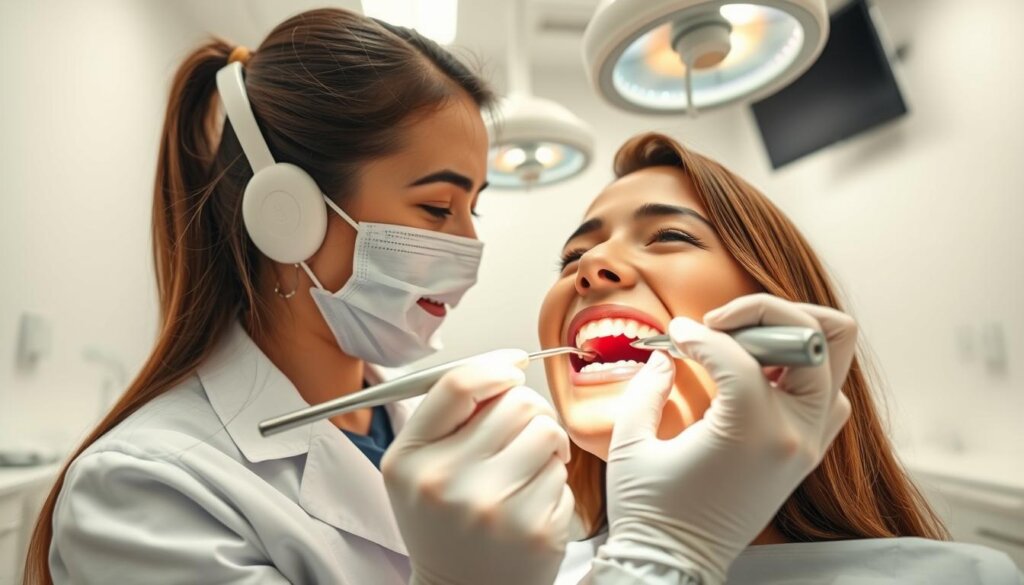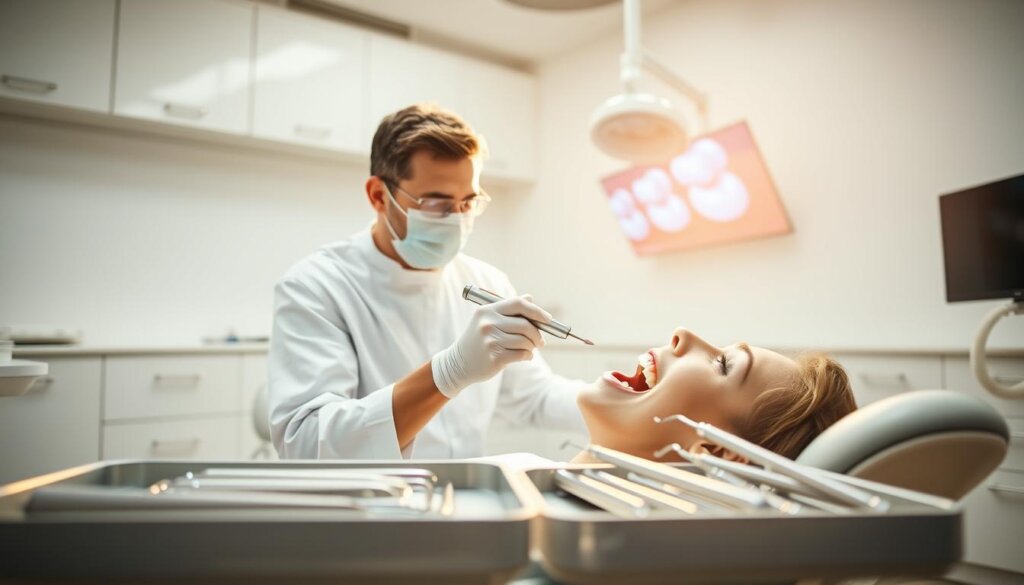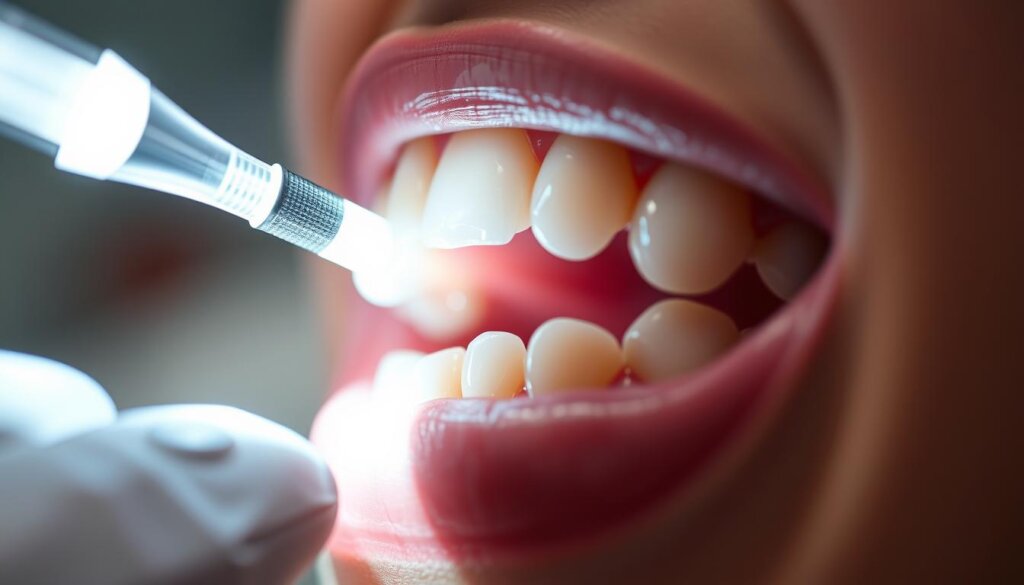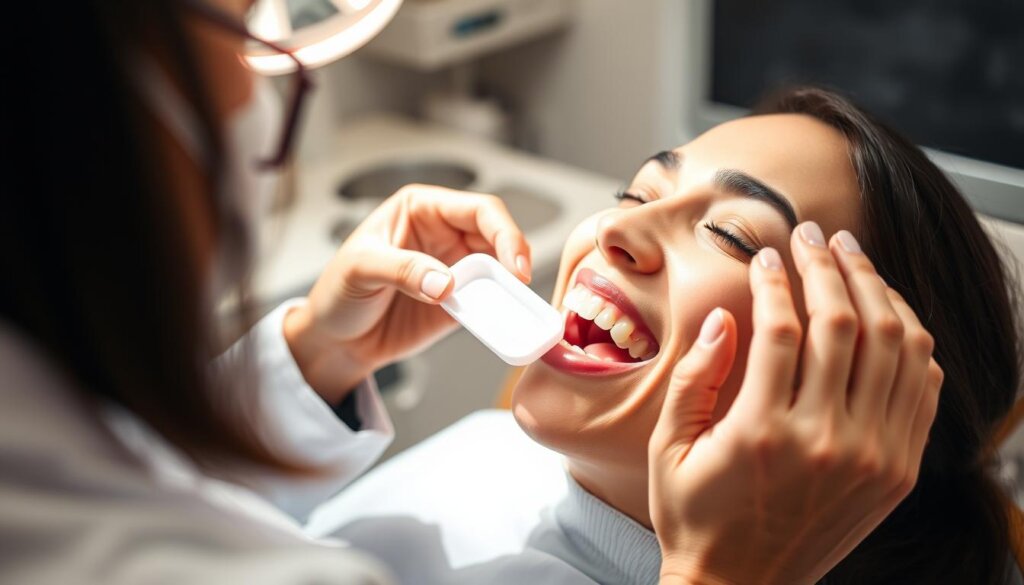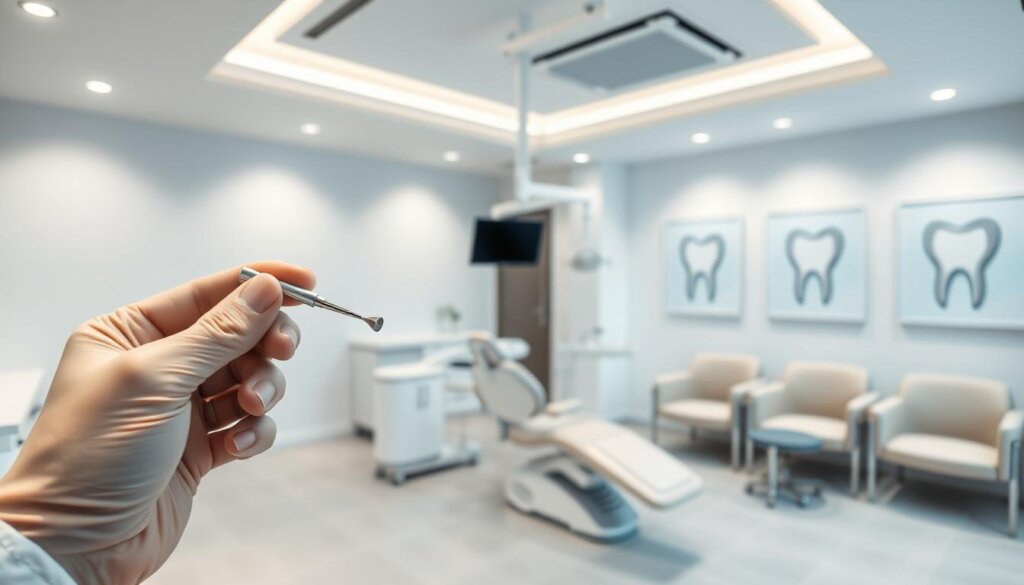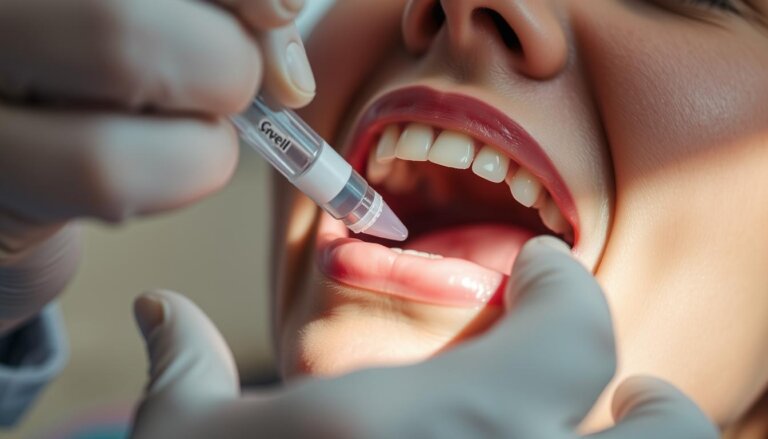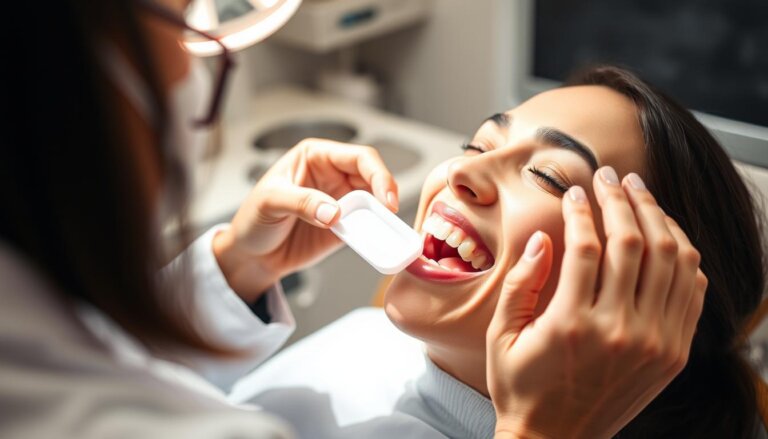Can Cleanings Whiten My Teeth or Remove Stains?
Around 39.2% of grown-ups choose teeth whitening to make their smiles brighter. This shows how much people want whiter teeth. However, some confuse teeth cleaning with teeth whitening as ways to get rid of stains. Teeth cleaning helps keep your mouth healthy by removing plaque and tartar. These substances can make your teeth look dull and yellow. But teeth cleanings are mainly to prevent cavities and gum disease, not to make your teeth white. To remove stains from things like coffee, tea, and smoking, you need special treatments.
When you get your teeth cleaned, the dental hygienist removes plaque and tartar. This might make your teeth look a bit whiter. But, deep stains and discoloration, especially as you get older, need professional whitening to really change. Going to the dentist regularly for cleanings can help stop more stains and keep your smile bright.
Key Takeaways
- Teeth cleaning focuses on health, while teeth whitening is for looks.
- Cleanings can get rid of some stains but don’t change the teeth’s real color.
- Visiting the dentist often is key to avoiding new stains.
- Combining cleanings with whitening treatments can give better results.
- Knowing the difference between these methods helps in choosing the right treatment.
Understanding Dental Cleanings: An Overview
Regular dental cleaning is key to keeping your mouth healthy. It boosts your dental health and stops diseases. Knowing what happens during a cleaning, the types you can get, and how often you should get them is vital for great oral care.
What Happens During a Dental Cleaning?
A teeth cleaning procedure starts with a detailed check for tooth decay or gum issues. Then, the cleaning begins. During this step, plaque and tartar are removed with special tools to avoid cavities and gum disease. Next, teeth are polished and flossed to get rid of surface stains and debris. The process often ends with a fluoride treatment for extra protection against bacteria.
Types of Dental Cleanings
Dental cleanings vary. The regular type, called prophylaxis, is for those with good oral health. It keeps the mouth clean and healthy. For people with gum disease, a deeper clean called scaling and root planing is done. This targets harmful bacteria below the gums.
Frequency of Dental Cleanings
How often should you get a dental cleaning? Dentists usually say every six months. But, if you have had dental problems like cavities or gum disease, you might need cleanings more often. Going every three to four months can help deal with these issues better.
The Role of Plaque and Tartar in Teeth Staining
Good dental health means knowing how plaque and tartar cause tooth stains. Plaque is a sticky bacteria layer on your teeth leading to stains. If not removed, plaque turns into tartar, which sticks to enamel and is harder to get rid of.
How Plaque Affects Tooth Color
Plaque gathers colors from what we eat and drink, clinging these to our teeth. It ruins the look of our teeth and lets more bacteria grow. This makes good dental care even more crucial.
Impact of Tartar Buildup
Without removing plaque promptly, it becomes tartar. Tartar is harder to clean and more noticeable because of its yellow or brown color. The depth of this color can make stains on teeth more visible. Therefore, getting rid of tartar professionally is key, as it sticks tightly to the enamel and needs special dental tools for removal.
Removing Tartar from Your Teeth
It’s key to have a dentist remove tartar. Dental pros use special tools and methods to take tartar off safely, making your teeth white again and keeping them healthy. Getting your teeth cleaned by a dentist regularly stops plaque from becoming tartar. This keeps your smile bright and healthy.
Professional Cleanings vs. At-Home Care
The debate on professional cleanings versus at-home dental care is key for good oral health. Professional cleanings bring benefits that home care can’t match. With special tools, dentists remove plaque and tartar that regular brushing misses. This deep clean is vital to keep gums and teeth healthy.
Professional dental cleaning importance is huge. It’s not just about cleaning. Dentists also check for early signs of gum disease or oral cancer. They give fluoride treatments and dental sealants, protecting teeth from decay.
At-home care, while convenient and cheap, has its limits. Daily brushing and flossing can’t get rid of all tartar and plaque. Without a dentist’s tools and knowledge, it’s easy to miss spots and not clean teeth well. Plus, people don’t get the expert advice on the best ways to care for their teeth at home.
Going to the dentist regularly is key for top oral health. It’s not just about getting your teeth cleaned. Dentists also teach you how to look after your teeth at home. They adjust preventive care based on your specific dental needs to avoid future issues.
The differences between professional cleanings and at-home care show why both are needed. Using both, guided by a dentist, is the best way to keep your mouth healthy.
How Teeth Whitening Works
Teeth whitening uses peroxide-based compounds to make natural teeth brighter. These agents go deep into the enamel’s pores to remove stains. These stains can be from food, drinks, and other sources. Learning about teeth whitening options, like professional services and DIY kits, helps people pick the best one.
Different Teeth Whitening Methods
There are many ways to whiten teeth. Dentists can do it in their office using strong peroxide gel. This method works fast and has clear results. On the other hand, DIY whitening kits have weaker peroxide. These kits come as strips, trays, or pens. You must use them regularly for a while to see results.
Comparing Professional and At-Home Whiteners
The table below shows how professional whitening compares to DIY kits:
| Aspect | Professional Teeth Whitening | At-Home Teeth Whitening Kits |
|---|---|---|
| Concentration of Peroxide | High | Low to Moderate |
| Application Method | Applied by Professionals | Self-applied |
| Time for Visible Results | Immediate to a few Days | Several Days to Weeks |
| Cumulative Effectiveness | High | Moderate to High depending on Consistency |
Effectiveness of Whitening Kits
How well at-home whitening kits work depends on a few things. These include the original tooth color, stain type, and how often you use the kit. Using the kits regularly is key to get and keep your teeth white. They are cheaper and handy but work slower than dentist services.
Whether you pick professional whitening or a DIY method, think about your staining, tooth sensitivity, and how quick you want results. Talking to a dentist can help. They give advice that’s safe and works well for whitening your teeth.
Factors That Cause Teeth Stains
To get rid of teeth stains and keep your smile bright, it’s key to know what causes them. Things like what we eat, smoking, and getting older can change the color of our teeth over time.
Foods and Beverages That Stain Teeth
Some foods and drinks are known for staining teeth. Coffee, tea, red wine, and colored sodas have pigments that stick to the teeth. It’s important to prevent and treat these stains for a clean smile.
Tobacco Use and Its Effects on Tooth Color
Using tobacco, either by smoking or chewing, leaves deep stains from tar and nicotine. These stains are hard to remove and often need a dentist’s help to get rid of them.
Aging and Natural Discoloration
As we get older, our enamel thins, showing the yellower dentin. Also, stains that have built up over time get more noticeable. To handle these stains, special teeth stain removal techniques are needed.
| Source of Stains | Types of Stains | Removal Techniques |
|---|---|---|
| Foods and Beverages | Extrinsic | Whitening toothpastes, professional cleanings |
| Tobacco | Intrinsic | Professional bleaching, laser treatments |
| Aging | Intrinsic | Veneers, bonding, professional bleaching |
Working on preventing and managing both extrinsic stains and intrinsic stains makes a big difference in how your teeth look and your overall oral health. But, talking to a professional is best to find the right treatment for each kind of stain.
Can Cleanings Completely Whiten Your Teeth?
Many people think a dental cleaning will make their teeth white again. But it’s important to know what cleaning does. It doesn’t bleach teeth to a bright white.
Cleanings get rid of plaque and tartar which can make teeth look dull. They make teeth look cleaner and a bit brighter. But, since they don’t have bleach like dental whitening does, they don’t change your teeth’s real color. They just remove stuff on the outside.
Limitations of Dental Cleanings for Whiteness
Regular cleanings can’t get rid of stains deep in your teeth. For those, you need professional whitening. Cleanings are important for health but don’t whiten like treatments do.
Expectations from Cleanings
It’s key to have real expectations. A dental cleaning can make your teeth look nice and clean. But it won’t make them much whiter. For real whitening, talk to your dentist about dental whitening that can work for you.
The Benefits of Regular Dental Cleanings
Regular dental cleanings are key to good oral health. By looking into the many teeth cleaning benefits, people can understand why these habits are essential to preventative dental care.
Dental cleanings are our main defense against oral health issues. They keep our dental hygiene top-notch, which helps avoid tooth decay and gum disease. Not only do they keep teeth healthy, but they also make them look better.
- Improved Oral Health and Hygiene: Regular cleanings take away plaque and tartar that brushing and flossing can’t. This keeps teeth and gums healthy and free from disease.
- Prevention of Tooth Decay and Gum Disease: Cleanings lower the chance of getting these common but serious issues by keeping the mouth clean and checking early for decay signs.
- Enhanced Aesthetic Appearance: Beyond health, dental cleanings also have cosmetic benefits. They get rid of surface stains and polish teeth, leading to a brighter smile.
Encouraging regular teeth cleaning benefits boosts dental health and promotes a proactive attitude towards it. This fits well with preventative dental care objectives, aiming to tackle oral health problems early. Dental cleanings are integral for long-term health, helping people maintain both their oral and overall well-being.
Combining Cleanings with Whitening Treatments
For the best results in dental whitening, it’s smart to do it with regular cleanings. This approach makes sure the teeth are ready for whitening and boosts the look of cosmetic dental work.
After a cleaning, your teeth are free of plaque and tartar. This makes them perfect for professional teeth whitening. Dentists often suggest scheduling whitening treatments right after a cleaning to use this clean state.
| Treatment Type | Description | Duration |
|---|---|---|
| In-Office Bleaching | Fast-acting chemicals applied under professional supervision | Approx. 1 hour |
| Laser Whitening | Laser technology combined with bleaching agents for deep stains | Approx. 30 mins |
| Take-Home Trays | Custom trays filled with bleaching agent for home use | Several weeks |
Dentists say it’s key to pick the right dental whitening treatment for your needs and health. For quick results, things like laser whitening at the office are good. But take-home trays might be better for those who prefer slow changes.
Mixing teeth cleaning and whitening not just boosts how you look but also your self-esteem. With their dentist’s guidance, patients can get stunning, lasting whiteness. This keeps both their smile’s health and beauty on point.
The Cost of Dental Cleanings and Whitening Procedures
Understanding the cost of keeping a smile healthy and bright is key. This section looks at the expenses for dental cleanings and teeth whitening. It also covers how dental insurance helps with these costs. When looking for routine or cosmetic dental care, it’s smart to know the costs involved.
Professional dental cleanings keep your mouth healthy and your smile looking good. The type and frequency of cleaning affect the cost. Teeth whitening is becoming more popular, raising questions about its cost. Remember, dental insurance may cover cleanings but often doesn’t cover whitening because it’s cosmetic.
| Service | Average Cost | Insurance Coverage |
|---|---|---|
| Standard Cleaning | $100 – $200 | Often covered partly or fully |
| Deep Cleaning | $150 – $350 | Varies by plan |
| Teeth Whitening | $300 – $600 | Rarely covered |
It’s important for patients to talk to their insurance company to understand what’s covered. Knowing what your dental insurance covers helps manage costs better. Since dental plans differ greatly, some might cover preventive care well but not cosmetic procedures.
Investing in dental cleanings and whitening boosts both dental health and confidence. By knowing the costs and insurance details, people can work towards a beautiful smile. This avoids unexpected financial burdens.
Home Remedies for Whiter Teeth
People often try DIY solutions to get bright, sparkling teeth. They use natural teeth whitening agents hoping to improve their smile without a dentist’s help. Yet, how well and safely these methods work varies a lot. Here, we discuss popular homemade options, their possible risks, and how they stack up against professional whitening.
The appeal of DIY teeth whitening is its easy access and the simple home methods available. Ingredients like baking soda, hydrogen peroxide, and fruit peels are favored for their whitening claims. However, there’s worry about their correct use and effects on dental health over time.
It’s important to know the risks and limits before trying any DIY teeth whitening method. Using natural acids and rough materials wrongly can hurt your enamel. This damage could mean higher costs for fixes later. Plus, while you might see some stains go away, home methods can’t match the quality or lasting effect of professional treatments.
- Natural Ingredients for Teeth Whitening: Items like turmeric, coconut oil, and activated charcoal are often recommended online for teeth whitening. Their popularity is high, but they don’t work as well or as reliably as dentist methods.
- Risks of DIY Teeth Whitening: Trying it yourself could cause patchy whitening, sensitivity, or harm if acids are used wrongly. It’s tough to get the concentration and application right without professional advice.
- Efficacy of Home Remedies Compared to Professional Care: Dentists have high-quality materials and precise methods to ensure safe, effective treatment. Home solutions might slightly lighten teeth, but the results are less dependable and short-lived.
In summary, the idea of teeth whitening home remedies might sound tempting, but it’s vital to know the risks and limited benefits. For dependable, safe, and proven whitening, professional services are the better choice.
Tips for Maintaining Whiter Teeth After Cleanings
After a dental cleaning, keeping your teeth white is a top goal. It’s vital to have a good oral care routine, change some habits, and maybe get more dental treatments. We’ll show you how to keep your smile bright.
Recommended Oral Care Routines
Having a solid oral care plan is key for white teeth. Brushing twice daily with fluoride toothpaste, flossing every day, and using mouthwash prevents stains. Also, seeing your dentist often helps catch any issues early.
Foods and Habits to Avoid
To stop stains from coming back, avoid things like coffee, red wine, and tobacco. These can spoil the look of clean, white teeth.
Follow-Up Treatments and Products
Getting follow-up dental treatments is important to keep teeth white. Touch-up sessions with your dentist can remove new stains. Plus, using whitening products your dentist suggests is very helpful in maintaining teeth whiteness.
| Activity | Daily Frequency | Product Recommendations |
|---|---|---|
| Brushing | 2-3 times | Fluoride toothpaste |
| Flossing | Once | Dental floss, water flossers |
| Mouthwash | Once or twice | Antiseptic mouthwash |
Following these tips helps a lot in keeping your teeth white and healthy. Staying true to your oral care routine, choosing your lifestyle wisely, and getting dental treatments when needed are key. This is how you keep that smile shining.
The Role of Toothpaste in Teeth Whitening
Whitening toothpaste is key for a brighter smile. It tackles surface stains with special gritty elements. It’s an easy, everyday choice for improving your smile.
Whitening Toothpaste Explained
Toothpaste for teeth whitening has mild scrubs and chemicals that shine teeth and break down stains. Its goal is to clean off surface marks from food, drinks, or smoking. It does this without changing the tooth’s true color.
How Effective Are Whitening Pastes?
Whitening toothpaste works differently for everyone. It depends on the stains and how you care for your teeth. These toothpastes remove surface stains well. For deeper stains, though, you might need stronger treatments.
Considerations When Choosing Toothpaste
Picking the right whitening toothpaste needs careful thought. You want something that cleans without harming your mouth. Here are important tips:
- Ingredients: Choose toothpaste that both whitens and hydrates, keeping enamel safe.
- Formulation Strength: Stronger toothpaste might work faster, but could make some people’s teeth sensitive.
- Sensitivity: If your teeth are sensitive, find a toothpaste that’s gentle but still works.
It’s important to pick a whitening toothpaste that suits your dental needs. Talking to a dentist can help you choose right. They can also suggest how to best care for your teeth.
Debunking Myths About Teeth Whitening
When you think about getting a brighter smile, knowing what’s true and what’s not is key. There are many myths about teeth whitening that confuse people. It’s important to know the real facts about dental whitening.
Some people believe wrong things about how to make their teeth whiter. They think some products or methods work instantly. Let’s look at these myths and learn the truth about teeth whitening.
Common Misconceptions About Whitening
- Whitening toothpaste can replace professional treatments.
- Whitening is harmful and weakens teeth.
- All teeth whiten equally regardless of original shade or condition.
Facts vs. Fiction
- Fiction: Over-the-counter kits work just as well as professional treatments.
- Fact: Professional whitening uses stronger agents in a careful way, leading to better and more lasting changes.
- Fiction: Whitening fixes all types of discoloration.
- Fact: Whitening best removes surface stains (like from coffee, red wine), but it’s less effective on deep stains (like from certain medicines).
The Science Behind Teeth Whitening
The main method in professional teeth whitening uses peroxide-based cleaners. These cleaners break down stains on the enamel, making your teeth look whiter. Knowing how this works helps set the right expectations for teeth whitening results.
Signs You Need a Dental Cleaning
Getting dental checkups regularly is key for keeping your mouth healthy. But, knowing when to get extra help is sometimes missed. If you feel something might be wrong, like symptoms of dental issues, see your dentist. These signs could be things you see or feel, which you shouldn’t ignore.
| Symptom | Description | Recommended Action |
|---|---|---|
| Visible Tartar Buildup | Hard, calcified deposits on teeth near the gum line | Schedule a cleaning appointment |
| Changes in Tooth Color | Yellowing or browning, often indicative of staining or decay | Consult dentist for a thorough cleaning |
| Persistent Bad Breath | Continuous unpleasant oral odor | Consider both dental cleaning and a check for underlying issues |
If you’re worried about these signs, don’t wait to make a dentist appointment. Cleanings do more than just make your smile look nice. They’re important for catching and dealing with oral health problems early on.
Think about how good it feels to be sure your teeth are properly cared for. Keeping up with the dentist trips they suggest, like cleanings every six months, is smart. But if you’re having any trouble, it’s better to go in sooner than later.
Finding the Right Dental Professional for Cleanings
Finding a great dentist is crucial for good oral health. Choosing a dentist is more than just finding a convenient location. You should look at their qualifications and the care they offer. Make sure the dentist meets your dental needs and maintains high cleaning standards.
What to Look for in a Dentist
Start your search for a dentist with a few key points in mind. Check their education and if they can legally work in your area. See if they keep learning and offer many services. A good dentist makes sure you’re comfortable and gets personalized care.
Understanding Dental Credentials
Knowing your dentist’s credentials is important. Credentials show they’re committed to high standards in dentistry. They should follow strict ethical rules and aim for the best care. Ask if they have special training for any specific dental work you need.
Importance of Patient Reviews and Testimonials
Reviews from patients are very valuable. They give you a real look into what to expect. You’ll learn about the office, staff, and how the dentist works. Reviews show if people were happy with their dental care. Reading them helps you choose a trusted dentist for your needs.

